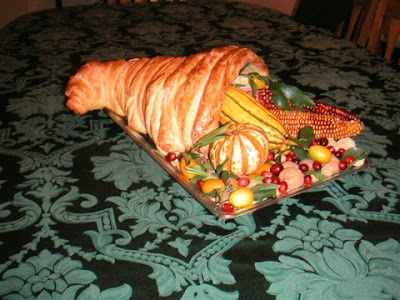Have a cookie making marathon in your future? Invest a few minutes and make a bulk-cookie cutter, and save tons of time.
This bulk cutter uses the dough efficiently, and allows a bunch of cookies to be cut at once. The only difficult part is eating all that tuna!

I used the following materials:
- seven cans of tuna (eat the tuna and wash the cans)
- 18" heavy duty aluminum platter (rescued from a catered community event, but too large to fit in my oven's drawer!)
- seven 1.5" brads
- duct tape
These are the tools I used:
- drill with bit smaller than the head of the brads used
- scissors
- pliers (helpful for bending the foil pan, but not strictly necessary)
- pen that marks on foil pan (e.g. Sharpie/permanent marker)
- glue gun (optional, probably unnecessary)
Instructions:STEP 1: Collect and thoroughly wash a number of tuna fish cans.
I soaked mine for a few minutes in hot water that had some lemon juice added to remove the fishy odor, then ran them through a dishwasher.
STEP 2: Drill a hole in the center of the bottom of each can.

STEP 3: Mark the hole locations on the foil platter, grouping the cans as close together as possible.

STEP 4: Drill holes in the platter at the pen marks.
 STEP 5: For each can, feed a brad through the hole in the can and the corresponding hole in the platter. Open the brad on the back of the platter, pull tight and curl the "legs" of the brad to secure. The cans should be able to spin, but not wobble.
STEP 5: For each can, feed a brad through the hole in the can and the corresponding hole in the platter. Open the brad on the back of the platter, pull tight and curl the "legs" of the brad to secure. The cans should be able to spin, but not wobble.
STEP 6: (Optional) I put a dot of hot glue from a glue gun on the back of the platter, to help secure each brad. This was probably unnecessary, but can't hurt.

 STEP 7: Cut the platter from its edge to the outside of the can, for each of the outer-most cans. (There are six outer-most cans in this configuration.)
STEP 7: Cut the platter from its edge to the outside of the can, for each of the outer-most cans. (There are six outer-most cans in this configuration.)
 STEP 8: Fold two opposing "leaves" cut from the platter over the back of the platter.
STEP 8: Fold two opposing "leaves" cut from the platter over the back of the platter.
The idea is to reinforce the strength of the cutter and make it safe for pushing with palms (no sharp edges) when in use.


 STEP 9: After the initial two edges are folded in, snip (with scissors) a wedge from the edges of the remaining flaps (to reduce bulk) and fold them in to the back of the platter.
STEP 9: After the initial two edges are folded in, snip (with scissors) a wedge from the edges of the remaining flaps (to reduce bulk) and fold them in to the back of the platter.
I used a pair of pliers to help with the folding.
Make sure all sharp edges are removed and folded. Your hands will be pushing on this device, and those snippets of aluminum can cut skin!


This is the shape of the wedge removed from the flap sides. With six cuts, I had six flaps and six wedges.

STEP 10: When all the flaps are folded over, crimp the folds with the pliers and cover the exposed edges with duct tape.


STEP 11: Whip up some cookie dough and go to town!


This worked well, and it's sturdy enough that I plan to keep it indefinitely. I drilled a hole in the edge so I could hang it on my basement stairwell wall, where I keep most of our other baking pans. (This is a storage strategy that allows all the pans to be visible, while freeing up considerable cabinet space.)
Here is a picture of it (bottom center of the photo) hanging on the Wall o'Pans:

(Update:
Wonder what to do with the lids?)






















 Oh, my, but Shabbat gets in early this week. In Boston, now that Daylight Savings changes have been made, candle lighting is 4:11 p.m. today!
Oh, my, but Shabbat gets in early this week. In Boston, now that Daylight Savings changes have been made, candle lighting is 4:11 p.m. today!


















